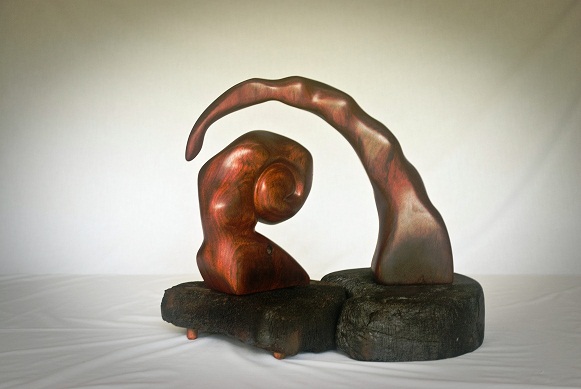By ELIZABETH LOLARGA
WHERE once he was an infant so fragile that the family pastor was called in to baptize and give him the last rites, Julian V. Araos has learned to be street smart, even in coping with the still painful loss of his father Jerry, whom he calls “Ama.” Like a mature man, he has transformed mourning into a period of renewed creativity.
Araos opened today his first show of sculptural pieces made solely for art’s sake. He said, “In the past my works were functional sculptures that highlighted their aesthetic appeal along with their utilitarian purpose. This show, ‘Usbong,’ is one big step to challenge myself to come out of my comfort zone and expand my horizon.”
The Filipino word usbong means “to sprout,” “to develop.” He said he is exploring and rediscovering the craft. In the process, he rediscovers himself. “ My inspiration for my works is Nature — forms mimicking ferns unfurling. Although the suggestions of human form are there, they’re premature, not quite defined. As ferns they’re just about ready to stretch out and face the sun. As human forms, they are bowed down in grief, hesitant to look up and face a world that seems bigger without a guide, a father, a mentor. This reflects my process of self-discovery and personal struggle,” Araos explains.
He aspired to make figurative sculptures, but considered his life experiences “hilaw pa (still raw). “After the death of Ama, somebody challenged me to have exhibit sculptures in figurative form dahil anak ako ng tatay ko (because I’m my father’s son). I took up the challenge,” he says.
His works adhered to his father’s philosophy: “Art is a concentrated expression of life.” Araos adds, “I am expressing what I feel as a son who lost a father, as a student who lost a master, a practitioner who lost an idol.” He applied Ama’s practical advice: “You should work with what you have and respect the material at the same time.”
While playing as a boy in Jerry’s studio, he learned the names of wood, familiarized himself with the tools and eventually was taught how to operate them.
Araos describes Jerry: “As a father, he was beyond compare. He had his own style on how to discipline us. He had an incredible way of showing his love and affection. I can’t explain it, but I wouldn’t have it any other way. As a master, he taught me how to live life. The most important lesson is that there are some mistakes you should experience firsthand. It is hard and painful, but you’ll never make the same mistake again. As a friend, he’d tease you, even make you cry. But like a true friend, he’ll always be there for you when you need him.”
After his last show in’09, he became his father’s “full-time alalay. “We did gardening together, construction of the house together, did sculpture together.”
He surprised his mother, Melendre ,with his new works. She shares that she was worried when Julian was challenged to do away with functional sculptures. “ Although he practically grew up with his father doing figurative pieces, he never ventured into this, had no formal training at all.”
She says Julian pieces reflect his grief with the loss of his father . But she is happy that “He is trying to sprout anew after a great loss. To say the least, I am proud of his works.”
She commends her youngest child, now 28, for having been “very caring, thoughtful and loving during the two to three years when his father’s health deteriorated.. He was with his father all the way, helping him with his landscaping projects, with the construction of our house, putting up his art exhibits and accompanying him during dialysis days when I couldn’t be there. After his father’s death last December, he was there for me, too.”
Araos said his father left materials and responsibilities. There’s a lot of wood that can be used for chairs, tables, cabinets. He says, “The garden in Antipolo continues to be a challenge. He left a sculpted garden I need to tend.”
He admires other artists for their specific work or style. He says, “If I have to highlight someone, it would be AG Sano. He combines his advocacy with his art. His love for the environment is transmuted to public art, elevating public awareness to save the environment.” (Sano is the mural artist behind the “Dolphins Love Freedom” movement.)
Meanwhile, the usbong, this bud of an artist continues to grow in his art that is indelibly marked by the soul of a greater artist.
(“Usbong” is on view at the Crucible Gallery of SM Megamall, Ortigas Center, Mandaluyong City, from Sept. 10-22.)
